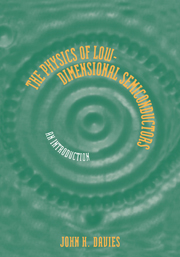Book contents
- Frontmatter
- Contents
- Preface
- Introduction
- 1 FOUNDATIONS
- 2 ELECTRONS AND PHONONS IN CRYSTALS
- 3 HETEROSTRUCTURES
- 4 QUANTUM WELLS AND LOW-DIMENSIONAL SYSTEMS
- 5 TUNNELLING TRANSPORT
- 6 ELECTRIC AND MAGNETIC FIELDS
- 7 APPROXIMATE METHODS
- 8 SCATTERING RATES: THE GOLDEN RULE
- 9 THE TWO-DIMENSIONAL ELECTRON GAS
- 10 OPTICAL PROPERTIES OF QUANTUM WELLS
- A1 TABLE OF PHYSICAL CONSTANTS
- A2 PROPERTIES OF IMPORTANT SEMICONDUCTORS
- A3 PROPERTIES OF GaAs–AlAs ALLOYS AT ROOM TEMPERATURE
- A4 HERMITE'S EQUATION: HARMONIC OSCILLATOR
- A5 AIRY FUNCTIONS: TRIANGULAR WELL
- A6 KRAMERS–KRONIG RELATIONS AND RESPONSE FUNCTIONS
- Bibliography
- Index
7 - APPROXIMATE METHODS
Published online by Cambridge University Press: 05 June 2012
- Frontmatter
- Contents
- Preface
- Introduction
- 1 FOUNDATIONS
- 2 ELECTRONS AND PHONONS IN CRYSTALS
- 3 HETEROSTRUCTURES
- 4 QUANTUM WELLS AND LOW-DIMENSIONAL SYSTEMS
- 5 TUNNELLING TRANSPORT
- 6 ELECTRIC AND MAGNETIC FIELDS
- 7 APPROXIMATE METHODS
- 8 SCATTERING RATES: THE GOLDEN RULE
- 9 THE TWO-DIMENSIONAL ELECTRON GAS
- 10 OPTICAL PROPERTIES OF QUANTUM WELLS
- A1 TABLE OF PHYSICAL CONSTANTS
- A2 PROPERTIES OF IMPORTANT SEMICONDUCTORS
- A3 PROPERTIES OF GaAs–AlAs ALLOYS AT ROOM TEMPERATURE
- A4 HERMITE'S EQUATION: HARMONIC OSCILLATOR
- A5 AIRY FUNCTIONS: TRIANGULAR WELL
- A6 KRAMERS–KRONIG RELATIONS AND RESPONSE FUNCTIONS
- Bibliography
- Index
Summary
Few problems in physics and engineering can be solved exactly, and one has to resort to approximate or numerical methods. Consider, for example, an electron in a square well whose potential is tilted by applying an electric field. The energy and wave function of its states change only slightly if the field is small. The lowest state becomes polarized to the deeper part of the well, causing a quadratic reduction in its energy. Perturbation theory provides a framework for calculating such changes, and this example is discussed in Section 7.2.
This approach works well if the potential can be divided into a ‘large’ part that can be solved exactly and a ‘small’ perturbation. Other methods must be used if this is not the case. The WKB method described in Section 7.4 is applicable to potentials that vary slowly in space, and is closely related to classical mechanics. The variational method (Section 7.5) gives only the energy of the ground state but has unrivalled accuracy and can include electron–electron interaction and other complications.
There are many applications to band structure. The k · p method in Section 7.3 gives the form of energy bands near a gap, the most important region in a semiconductor. Two general methods take opposite points of view. The tight-binding method (Section 7.7) is based on a picture of isolated atoms brought together to form the solid, where the bands originate from atomic levels.
- Type
- Chapter
- Information
- The Physics of Low-dimensional SemiconductorsAn Introduction, pp. 249 - 289Publisher: Cambridge University PressPrint publication year: 1997



